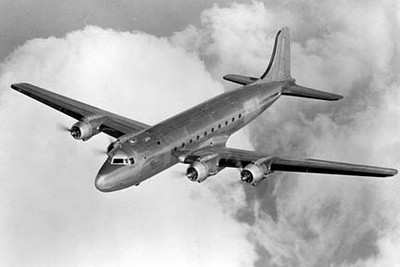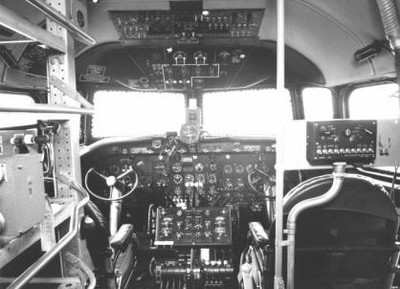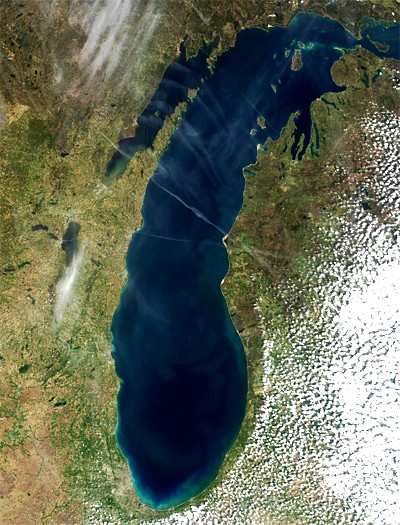Northwest DC-4 Disappeared In 1950
Fifty-six years is too long for the wreckage of a missing plane
to go undiscovered, say underwater search crews and amateur
historians who have launched an impressive effort to find the
remnants of Northwest Airlines Flight 2501. The DC-4 disappeared
over Lake Michigan in June 1950.

"It seems like it's certainly findable," said Ralph
Wilbanks, a member of the search team financed by
underwater adventure writer Clive Cussler. "It's just a mystery
what happened to this plane."
The Chicago Tribune reports crews were due to return to sites
identified by sonar and magnetometer sweeps earlier this week as
possible locations of wreckage from the plane.
In what was the deadliest US airline accident at the time, 55
passengers and three crew were lost when the airliner, bound for
Minneapolis from New York's LaGuardia Airport, disappeared near
Benton Harbor, MI on the night of June 23, 1950. The last contact
from the plane came when Captain Robert Lind requested a descent
from 3,500 feet to 2,500, presumably due to storm activity in the
area.
Controllers denied that request due to conflicting traffic...
but it's unknown whether Lind heard them. Airline officials
discovered the plane was missing when they learned the plane hadn't
passed over Milwaukee as planned.

An unprecedented search effort was launched, involving Air
Force, Coast Guard and Navy personnel, as well as police from every
state that borders Lake Michigan. Keep in mind this was 1950, far
before the days of cell phones and rapid response teams.
Many of those personnel headed toward Milwaukee, where witnesses
reported seeing a flash in the skies and an oil slick. But the
plane had evidently disappeared long before reaching Wisconsin.
Despite the misstep, it's unlikely crews could have saved anyone,
even if they had responded to the correct location.
Crews searched futility for the missing plane. In the hours
following the crash, debris from the missing aircraft began to wash
up on the shores 18 miles northwest of Benton Harbor. A fuel tank
float, pieces of arm rests, and body parts were recovered over the
following days... but the plane was never found. The search was
called off within a week, and subsequent hearings failed to arrive
at a cause for the crash.
"It is known that the flight entered an area where there was
severe turbulence and that it crashed shortly afterward," read the
government's final report. "This fact in itself indicates that the
accident probably resulted from either a structural failure caused
by the turbulence, or because control of the airplane was lost.
However, there is no evidence upon which a determination can be
made as to which of these two possibilities actually caused the
accident."
By the time the government released its report, most of
America's attention was focused on the escalating conflict in Korea
-- which the US entered one day after the loss of Flight 2501.

It seemed the crash would forever be lost to the pages of
history... until Cussler, who had already gained fame for his
team's discovery of the wreckage of the ill-fated Confederate
submarine Hunley in 1995, read an article by a member of the
Michigan Shipwreck Research Associates on the crash.
Members from that organization, along with Cussler's team, began
the search anew in 2004, with a follow-up search conducted last
May. The combined team found two shipwrecks, but still no sign of
the missing DC-4.
"We're finding everything there is to find, but no airplane,"
said Valerie Olson VanHeest, shipwreck group director and
co-founder of the Underwater Archaeological Society of Chicago. The
group also located relatives of three people who perished in the
crash, and even held a memorial service for them earlier this
month.
For the moment, however, the depths of Lake Michigan still hold
the secret to the disappearance of Flight 2501. That, combined with
the relatively small size of a DC-4, have made the search
difficult.
"If it was a 1,000-foot ship, this would be a lot easier,"
Wilbanks said, noting an intact DC-4 is only 95 feet long -- and
it's likely the plane has broken into several smaller pieces. But
the search will go on.
"I'd hate to not find this airplane," he said.
 Aero-News: Quote of the Day (05.13.25)
Aero-News: Quote of the Day (05.13.25) IAG Orders 76 Boeing, Airbus Airliners
IAG Orders 76 Boeing, Airbus Airliners FAA Shuts Down ATC Oversight Review Amid Scrutiny
FAA Shuts Down ATC Oversight Review Amid Scrutiny Montanas ADS-B Privacy Bill Signed Into Law
Montanas ADS-B Privacy Bill Signed Into Law Newark Falls Victim to More Equipment Outages
Newark Falls Victim to More Equipment Outages





